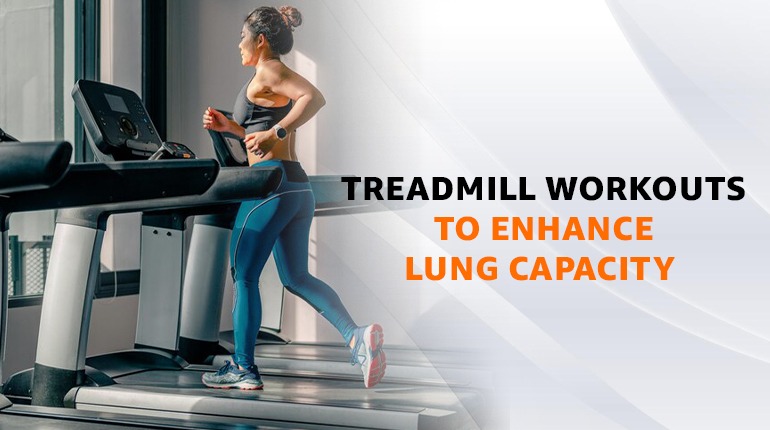Treadmill Workouts & Tips on How to Increase Lung Capacity

It’s fascinating to consider the remarkable abilities of our lungs. Breathing is something we often overlook, yet it’s a vital function of our bodies. But the good news is that you can actually enhance your lung capacity. One effective method to achieve this is by engaging in treadmill workouts. In this blog, we’ll delve into the concept of lung capacity, explore how treadmill workouts can be a powerful tool to boost it, and introduce you to three outstanding workouts that can have a significant impact on your respiratory health and overall fitness.
Why Lung Capacity Matters
When you’re physically active, your body needs more oxygen to fuel your muscles and keep everything running smoothly. When your lungs have a good capacity, you can inhale and exhale more air with each breath, making your breathing more efficient.
A larger lung capacity can directly impact your endurance. With the ability to take in more oxygen, you’ll be able to sustain physical activities for longer periods, whether it’s running, cycling, or any other form of exercise. This increased endurance can lead to better athletic performance.
People with higher lung capacities tend to have stronger respiratory and cardiovascular systems. It can help in maintaining good lung function as you age and may even reduce the risk of respiratory illnesses.
The Treadmill Connection
Treadmill workouts are a fantastic way to work on your lung capacity. They offer a controlled environment where you can gradually challenge yourself. Here’s how they help:
Treadmills allow you to maintain a steady pace, which is essential for improving lung capacity. It’s like setting the stage for your lungs to perform at their best. You can increase the incline to mimic uphill running, which forces your lungs to work even harder. This is like giving your lungs a challenging uphill climb to conquer. Treadmills are perfect for interval training, which involves alternating between high and low-intensity periods. This type of training can significantly improve your lung capacity.
Here are three treadmill workouts that can help increase lung capacity, explained in detail:
1. Interval Training
Interval training involves alternating between short bursts of high-intensity exercise and brief periods of low-intensity recovery or rest. This type of workout can be highly effective for increasing lung capacity.
How to do it:
– Start with a warm-up by walking or jogging at a comfortable pace for 5-10 minutes.
– Then, increase the treadmill speed and intensity to a level where you’re working at or near your maximum capacity. This should be challenging and cause you to breathe heavily.
– Maintain this high-intensity effort for 30 seconds to 2 minutes, depending on your fitness level.
– After the high-intensity phase, slow down and recover with a low-intensity period, typically lasting for the same duration as your high-intensity phase.
– Repeat this cycle of high and low intensity for a total workout duration of 20-30 minutes.
– Finish with a cool-down by walking at a slower pace for 5-10 minutes.
Interval training challenges your cardiovascular system and forces your lungs to work harder to provide oxygen to your body during high-intensity phases. Over time, this can lead to improved lung capacity and better overall endurance.
2. Hill Climbing:
Hill climbing on a treadmill simulates the experience of walking or running uphill, which requires more effort from your lungs and leg muscles.
How to do it:
– Begin with a warm-up by walking or jogging on a flat treadmill for 5-10 minutes.
– Increase the treadmill incline to create an uphill slope. Start with a moderate incline.
– Walk or run at a comfortable pace on the incline for 5-10 minutes.
– Gradually increase the incline level as you become more comfortable.
– Aim to maintain an elevated heart rate and slightly heavy breathing throughout the workout.
– After the hill climbing segment, reduce the incline and cool down with a few minutes of walking.
Hill climbing increases the resistance and effort required for breathing, helping to enhance lung capacity. It also engages different muscle groups, making it a versatile workout.
3. Speed Intervals:
Speed intervals involve alternating between short bursts of sprinting or high-speed running and periods of slower recovery.
How to do it:
– Begin with a warm-up by walking or jogging at a comfortable pace for 5-10 minutes.
– Then, increase the treadmill speed to a level where you can sprint or run at a high intensity for a short duration, typically 20-30 seconds.
– After the high-speed interval, reduce the treadmill speed to a recovery pace for 1-2 minutes.
– Repeat this cycle of high-speed and recovery intervals for a total workout duration of 20-30 minutes.
– Finish with a cool-down by walking at a slower pace for 5-10 minutes.
Speed intervals challenge your cardiovascular system, forcing your lungs to work harder during high-speed phases. This can lead to increased lung capacity and improved cardiovascular fitness.
Breathing Easier: Conclusion and Next Steps
In conclusion, increasing your lung capacity is a valuable step towards improving your overall respiratory health and fitness. Treadmill workouts, such as interval training, hill climbing, and long-distance running, can be powerful tools to achieve this goal. By challenging your lungs and cardiovascular system, these workouts not only enhance your capacity to breathe efficiently but also boost your endurance.
Remember to tailor your workouts to your fitness level and consult with a healthcare professional if needed. With dedication and consistent effort, you can enjoy the benefits of improved lung capacity and better well-being. So, lace up your sneakers, hop on that treadmill, and breathe in the benefits of a healthier, fitter you.
Also Read: HIIT Workout: 5 Proven Exercises to Improve Running Endurance
